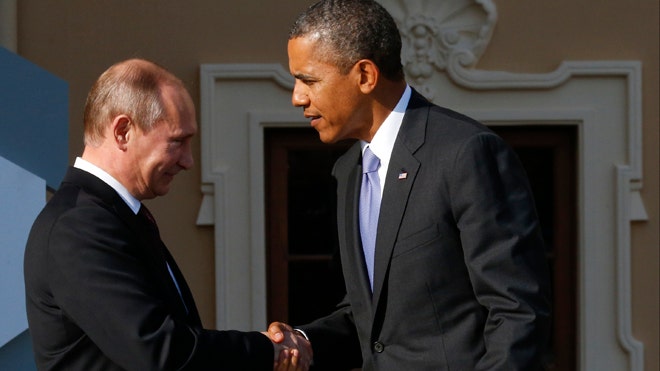Published on Monday December 30 2013 (AEST)

Sept. 5, 2013: Russia's President Vladimir Putin, left, welcomes
President Obama before the first working session of the G20 Summit in
Constantine Palace in Strelna near St. Petersburg, Russia. (Reuters) 
America’s energy industry is looking ahead after the mid-December conclusion of a post-Cold War deal between the U.S. and Russia that eliminated enough enriched uranium to fill 20,000 nuclear bombs -- and provided nearly 10 percent of total U.S. energy consumption over two decades.
NPR reports on the completion of the unlikely “Megatons to Megawatts” program under which the U.S. spent $17 billion since 1993 buying 500 tons of downgraded nuclear fuel culled from old Russian bombs then sold to commercial energy interests in America for use in their own reactors.
"The Megatons to Megawatts program made a substantial contribution both to the elimination of nuclear weapons material and to nuclear energy generation in the United States," U.S. Energy Secretary Ernest Moniz reportedly said upon the official conclusion of the historic program. "Nearly every commercial nuclear reactor in the United States received nuclear fuel under the program." And Matthew Bunn, a professor at Harvard University’s John F. Kennedy School of Government, calls the program one of the greatest diplomatic achievements in history. "I mean, think about it – 20,000 bombs' worth of nuclear material, destroyed forever," he told NPR. "[Bombs that] will never threaten anybody ever again." World Nuclear News reports that with the arrival of the final shipment of nuclear fuel – four cylinders worth – in Baltimore Harbor earlier this month from St. Petersburg, the program will now continue, albeit in a modified form.
Techsnabexport, or Tenex, a subsidiary of the Russian state nuclear energy company Rosatom, will now reportedly supply nuclear fuel to a private U.S. company for distribution. However, that fuel will originate from Russia's commercial enrichment of uranium, rather than the systematic transformation of former weapons materials.
The Megatons to Megawatts program is rooted in the aftermath of the former Soviet Union’s collapse in 1991. Philip Sewell tells NPR that shortly after the political situation unraveled, he visited old U.S.S.R. military facilities on behalf of the U.S. Dept. of Energy. "Windows were broken, gates were not locked, and there were very few people around," Sewell reportedly said, adding that the porous conditions provided ample opportunity for the potential theft of nuclear materials.
The solution was the Megatons to Megawatts program, or one the Russians initially rejected, but soon thereafter accepted in order to secure badly needed funds during what was then a time of national crisis. "It was a matter of pride, principle and patriotism," Sewell told NPR. "Even though they didn't need that excess material, [and] they didn't have the money to protect it, they didn't want to let go of it."
.
.
 Australian Uranium News - Research
Australian Uranium News - Research


No comments:
Post a Comment